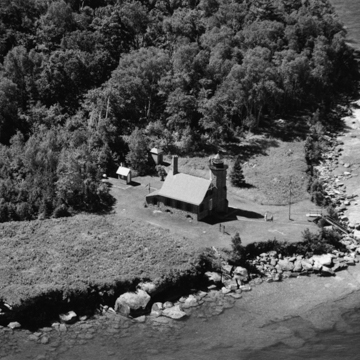On a rocky promontory on the western edge of the Apostle Islands, this lighthouse is the most picturesque of the archipelago’s seven light stations. In the 1880s, after ship captains requested more navigational aids to guide them between Superior, Duluth, and the locks in Sault Ste. Marie, Congress authorized the construction of this lighthouse. It appears to have been built from plans for the Chambers Island and Eagle Bluff lighthouses in the Green Bay–Lake Michigan corridor. The Gothic Revival structure consists of a keeper’s house and a forty-four-foot tower, both built of Chequamegon brownstone. The steeply pitched gabled roof, scrolled knee braces, and an attenuated gable ornament with a turned pendant lend the building an uncommon stylishness. Its segmental-arched windows feature vermiculated voussoirs, a particularly artistic touch. Attached at one corner, the lighthouse tower begins as a square structure then gracefully flows into an octagonal shape as it extends above the dwelling’s gabled roof. A ten-sided lantern with an iron walkway crowns the structure. In 1921, the Bureau of Lighthouses replaced the Fresnel lens with an automatic acetylene light. Most lighthouse keepers on the Apostle Islands lived isolated lives, but not here. Sand Island supported a year-round community of perhaps as many as one hundred farmers and fishermen. At the southeast tip was a summer resort, Camp Stella, where vacationers began coming in the late 1880s. A community of mostly Norwegian-immigrant families lived on East Bay. The island is one of twenty-one along the Apostle Islands National Lakeshore, which boasts some of the most pristine beaches and old-growth forests in the Great Lakes region.
You are here
Sand Island Lighthouse
1881. Northeastern point of Sand Island, Apostle Islands National Lakeshore (Accessible only by boat)
If SAH Archipedia has been useful to you, please consider supporting it.
SAH Archipedia tells the story of the United States through its buildings, landscapes, and cities. This freely available resource empowers the public with authoritative knowledge that deepens their understanding and appreciation of the built environment. But the Society of Architectural Historians, which created SAH Archipedia with University of Virginia Press, needs your support to maintain the high-caliber research, writing, photography, cartography, editing, design, and programming that make SAH Archipedia a trusted online resource available to all who value the history of place, heritage tourism, and learning.


